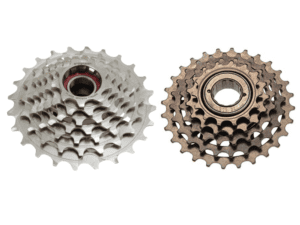Experienced bikers who spend a significant part of their free time on two wheels consider weight to be one of the most key characteristics and, when choosing a new model, try to find a middle ground between low weight and a high-quality bike.
Some of the popular manufacturers of mountain bikes don’t publish the weight of their bikes. On average, a mountain bike is expected to be between 28 lbs and 32 lbs. The important question is, does the weight of your mountain bike matter?
Let’s dive into more detail to find out the answer.
Does Mountain Bike weight matter?
It is a controversial issue. The weight of the bike is for many cyclists one of the most important and money-consuming elements. It is clear that if we can afford a top-of-the-range bike for $8,000, then surely we do not need to make any kind of improvement.
For most cyclists who have bikes of medium or medium-high range, the first thing they do is how they can lighten them.
For starters, let’s put the professionals aside. A typical mistake made by cyclists is to think: “If I change the wheels, stem, saddle, handlebars, seat post, handlebar tape, screws, etc.
I can save more than 1 lb of bike weight”. This, apart from being very expensive, is a BIG mistake. Weight must be measured as a whole: cyclist + bicycle.
As the University of Utah professor Jim Martin tells us: “A professional is very at the limit in his body weight, he only carries a bottle and something to eat.
An amateur is usually somewhat overweight (even a couple of kilos), carries a mobile phone, a backpack, and in some cases tools that won’t probably be needed.
When we want to lighten our bike, we tend to think: “If it weighs 20 lbs (9 kg) and I shave off 1 pound (500 grams), I am saving 5% of the weight of the bicycle.” The truth is that the equation must be: weight of the bicycle + weight of the cyclist.
If this is in 150 pounds (68 kg) the saving would be less than 1% of savings. Obviously, a 20 lbs mountain bike is faster than a 25 lbs bike, at least uphill.
Going down, the heaviest ones have an advantage, since their acceleration is greater. In this way, what your groupmates get from you by going up ports, you will recover by going down, and above, without spending so much money.
Let’s look at an example of two cyclists:
| Cyclist 1 | Cyclist 2 | |
| Bike Weight | 20 lbs | 25 lbs |
| Rider Weight | 145 lbs | 152 lbs |
| Total | 165 lbs | 177 lbs |
As you can see from the above example, a lighter bicycle doesn’t necessarily mean a lighter overall weight.
We are not saying that the weight of your mountain bike is not important, it is, but ONLY when you are very thin and your legs are strong. For an under-trained or overweight cyclist, this is of little importance.
According to Professor Gourley, ‘Everybody wants sexy bikes, but good legs are sexy too. I see a lot of people with very expensive mountain bikes but they have cheap legs. It’s like driving a Corvette with a two-cylinder engine. “
More important than the weight of the bike is aerodynamics. A lighter bike will certainly make you climb a bit faster. If you adopt a position that reduces wind resistance together with ideal wheel profiles, and tight clothing … you will improve much more than if you reduce the weight of the bicycle by 1 lb. Wheels are responsible for 30% of the resistance and our body for almost the rest.
Only knowing how to adopt a better position and better wheels will make a difference that is noticeable. A 19lbs bike is not essential to go very fast, the most important thing is the legs and then the aerodynamics.
How come Mountain Bikes are so heavy?
There is a simple answer to this question – mountain bikes are heavy because the components and the parts that they are made from have to be more durable. More durable means bigger, thicker, and stronger.
An increase in weight is only natural when the bicycle is intended to be ridden through rough tracks and terrains. The tires, frame, suspension, forks, wheels, handlebars, etc. all need to be capable of handling continuous rough riding.
- Tires – They are heavier on mountain bikes because they are simply thicker and wider than other types of bicycles’ tires. Thicker/wider rubber means more grip and traction on loose surfaces that MTBs are typically ridden. Thick tires are also more durable against punctures.
- Frame – Mountain bike frames are usually made from larger tubing with larger welding points, resulting in a sturdier frame. Every welding point adds extra weight to the bike. Also, frames come in different sizes to suit different-sized riders. Taller riders will be riding on bigger frames that weigh more. Another important point of sturdier frames is to absorb the impact of mountain riding – regular frames wouldn’t be able to handle it.
- Suspension – Road bikes do not need any type of suspension since they very rarely come across obstacles to rider over. Mountain bikes, however, face surface challenges at every bit of riding whether it’s the overall unbalanced terrain or larger rocks, woods and etc. This requires some sort of suspension, at least at the front. Hardtail mountain bikes will only have forks – a suspension system that is attached to the front of the bike. Then there are full suspension mountain bikes that have an additional suspension system in the rear of the bike. Full suspension MTBs are mainly for downhill type of riding where there’s lots of jumping, over-the-rock riding and etc. Any type of suspension means extra weight added to the bike.
- Disc brakes – Mountain biking is an extreme sport where being able to quickly slow down is essential, otherwise, there’d be a lot more accidents. Simple rim brakes don’t even remotely have the necessary stopping power for mountain biking purposes. That’s why disc brakes are the standard in MTBs and they weigh more than rim brakes.
- Drivetrain – Mountain bikes need a quality drivetrain that offers both durability and functionality and this comes at the cost of extra weight. If you have noticed, top-of-the-self bikes have lots of gears and they don’t just break after a couple of rough rides. This is because they are made of quality material that weighs a bit more than regular drivetrains.
Is 30lbs heavy for a Mountain bike?
A 30 lbs mountain bike is pretty much the average. It’s about the standard for an entry-level hardtail which most people start with. As you progress, you might want to move to more expensive models which will be lighter.
24-25 lbs are considered pretty good for a mid-range hardtail nowadays. You can obviously go lighter if you are willing to spend more $$ for your next bike.
What’s a good weight for a Mountain Bike?
Apart from beginner mountain bikes, the 24-28 lbs range is typically what you want. These bikes will offer you great stability without being too heavy to maneuver. With more experience under your belt, you can progress towards lighter bikes that may be less stable with more maneuvrability.
Average weight for different types of mountain bikes
- Hardtail – They are not designed for a specific type of terrain, but are used to do a bit of everything: forest tracks, dirt roads, rocky sections, and mountain paths. Hardtail bikes are the ones that most mountain bike fans use when they go out on routes and rides on a Sunday morning with no other pretense than riding at a light pace or exploring new trails. They are also very manageable when it comes to doing trails and descents that require a certain technique. On average, they weigh between 26-28lbs.
- Full-suspension – These bikes are geared for a single-use: speeding down a hill, a track, or an urban flight of stairs. They are semi-pro/pro bikes that are used in downhill races as well. The most common is that they have double suspension, with very wide damping travel in the suspension of up to 220mm. Their weight range is between 30-34 lbs.
- XC/Cross-country – Cross-country (also known as XC) is a competition mode where bikers have to cross mountain sections at high speed. There are usually no big declines. On the contrary, the paths tend to be flat or uphill with obstacles such as areas of stones, ramps, muddy terrain, or tracks that pose technical difficulties. They weigh 20-25 lbs in most cases.
- Downhill – Being designed for very specific functionality, such as high-speed descent, downhill bikes do not have many development options. It is common for the frame to be sloping, that is, the horizontal tube has an angular drop to lower the center of gravity and make the bike more maneuverable. An average downhill bike can be expected to weigh 35 lbs.
- 29er – Mountain bikes with 29-inch wheels (29ers) are great for riding over larger obstacles such as rocks, logs and etc. Their weight range is 28-30 lbs.
How to make a mountain bike lighter?
When you already have a mountain bike that you feel comfortable with and your budget is not large enough to buy a new lightweight bike, there is the possibility of lightening the weight of your bike.
But how to make your mountain bike lighter? There are many ways to do this, from ditching the accessories that add weight to them to swapping your heavier parts for lighter parts.
Keep the bike clean
Riding through dirt and mud gets your bike dirty, and as they accumulate, their weight becomes greater and could even affect the functioning of some parts. After every ride, quick cleaning of the bike could help reduce its weight.
Get rid of unnecessary accessories
Many mountain bikes have certain accessories that, while functional and convenient in certain situations, can be removed. These include the bottle holder, the wheel reflectors, the fenders, and any other type of cosmetic parts.
Replace the wheels with lighter ones
Wheels are one of the most important elements to lighten the weight of a bicycle. In addition, they have a direct impact on handling, acceleration, braking, and absorption of uneven terrain.
The first key point is the thickness. A wider wheel offers better traction, while a narrower wheel allows you to roll faster. Typically, a thicker tire is used on the front rim and narrower on the rear. To improve your performance on the bike, look for the combination of tires that best suits your riding style.
Replacing other parts
You can pretty much replace all the other parts of your bike as well. People often replace their handlebars, seats, pedals and etc. with lighter options to reduce the overall weight of their bike.
However, before doing so you should do the math and check whether the weight reduction is worth the prices of those new parts. As we mentioned earlier, the weight of your bike isn’t the biggest factor when it comes to your performance, it’s the rider that makes most of the difference.
When it comes to the weight of mountain bikes and whether you need a lighter bike, do not forget to assess other factors, such as your own fitness, knowing how to hydrate and eat on days that you ride, learning about the track and a long list of factors that are much more important than a few pounds of extra weight.
Because in the long run, if you are a good mountain biker, you will compensate more than enough for the extra weight of your bike. If you still decide to lose the weight of your mountain bike, do not forget to start with the wheels and your weight.
Conclusion
There are several ways to reduce the weight of your mountain bikes. The most effective way is by replacing heavier components with lighter ones. If you want to know which components are the heaviest, then just go ahead and take a look at our guide on the heaviest parts of a mountain bike.





